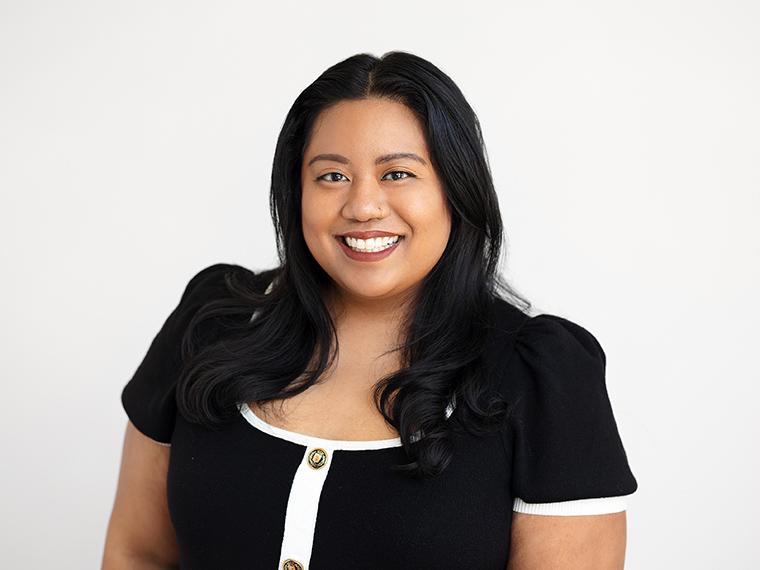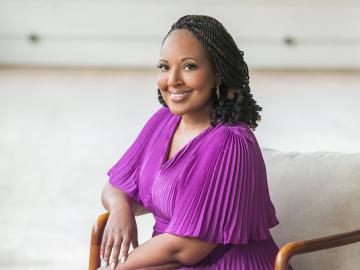Going Above and Beyond Diversity
May 8, 2023
Amanda Nagy

In spring 2023, Oberlin College and Conservatory appointed Kristen Surla as the institution’s first human resources director of diversity, equity, and inclusion (DEI). In this position, Surla plays a key role in promoting a culture of inclusive excellence and advancing strategic diversity hiring initiatives.
Surla comes to Oberlin from the University of Michigan, where she worked in the Office of Diversity, Equity, and Inclusion at the School for Environment and Sustainability. At Oberlin, she is primarily responsible for the recruitment and retention of faculty and staff from historically underrepresented backgrounds in higher education, supporting community building and retention efforts through affinity groups and mentoring programs, and offering professional development opportunities.
Surla is no stranger to the Oberlin community. From 2013-2016, she served as the Asian Pacific Islander Diaspora community coordinator in the Multicultural Resource Center (MRC), now known as the Multicultural Resource Commons. She went on to receive a master’s degree in education from Loyola University Chicago and is now working toward a PhD in higher, adult, and lifelong education from Michigan State University.
In the following Q&A, Surla discusses her research interests, her approach to an inclusive work culture, and the factors that brought her back to Oberlin.
First of all, welcome back to Oberlin! Can you start by talking about your past role here and your career journey up to this point?
Thank you! I’ve felt a warm welcome back to the community by former and present colleagues. It feels like a homecoming to be back at both Oberlin College and Conservatory and the town at large. My position in the MRC was my first job following graduation from Loyola University with a bachelor’s in sociology and English. Beginning my career at Oberlin was a formative start to understanding the ecology of liberal arts institutions of higher education. I learned a lot about how faculty and staff can create collaborative learning cultures with students in order to pursue research and teaching.
I loved working at the MRC because of its intersectional approach to programming and working with our campus community. Programs such as “My Name is My Own”—a series that featured leaders talking about intersectional identities and the impact of their lived and professional identities on their fields—was really instructive in forming my approach to DEI work. The collaborative programs I hosted with the other community coordinators in the MRC helped me better serve a diverse student population whose identities weren’t siloed to individual groups. For example, although my title was the Asian Pacific Islander Diaspora (APID) coordinator, I was also working with LGBTQIA+, Africana, and Latinx populations around shared priorities, programming, and student support. Many of our students span multiple communities, so this kind of advising model made sense for that reason.
After Oberlin, I went to graduate school for my master’s and PhD. My research focuses on academic socialization, faculty culture, and curriculum development in environmental education. Specifically, my dissertation examines practices of decolonizing curriculum within environmental education and how these movements push to prioritize Black, Indigenous, and People of Color (BIPOC) voices, place-based learning, and policies that recognize the history of how colonialism and the Global North has dominated discourse and research in this field. I hope my contributions can continue to diversify the methods we use to teach environmental education and support more BIPOC students who are pursuing environmental studies.
Explain your role as director of diversity, equity, and inclusion.
I’d summarize the work I do as recruitment and retention of faculty and staff from historically underrepresented backgrounds in higher education, supporting community building and retention efforts through affinity groups and mentoring programs, and providing professional development opportunities. Some of the professional development I’d like to focus on includes inclusive hiring practices, shifting academic culture toward a more justice-oriented lens, and supporting the overall well-being of our faculty and staff. To do this work, I think we have to intentionally analyze, reflect, and propose creative approaches to expectations of work culture, processes, and procedures to support employees’ overall well-being. I’d like for us to admit the ways we could do better in supporting faculty and staff and to create solutions together.
How does this position fill a need at Oberlin, and where will we see the impact?
I think Oberlin has done a good job at starting to increase its compositional diversity, but we need to be thinking more about how we create inclusive environments where faculty and staff feel supported in the requirements and workloads they have for research, teaching, and service. A quote that stays with me about doing DEI work is that “admission does not mean acceptance, and acceptance does not mean welcome. To be truly welcoming, we have to commit to creating environments where people are empowered and supported to share their diverse experiences, perspectives, and identities." Essentially, what I interpret from this quote is that we have to go beyond compositional diversity and recruitment to create infrastructures of community building and honest conversations where we can talk about what is really needed for faculty and staff to feel supported in their full selves. Creating longevity and decreasing turnover among faculty and staff are important indicators of how well we’re doing as an institution at DEI work.
What are some of your goals and objectives?
As the inaugural HR director of DEI, I’m still developing a list of priorities through listening and collaborating with faculty and staff around campus. I always think that the most important thing to do first in a job is to listen to the people who have already been doing or want to propose DEI work that they’ve been waiting to see on campus.
Some of my initial priorities focus on increasing recruitment and retention programs for faculty and staff from historically underrepresented backgrounds. In the upcoming academic year, I hope to collaborate with the college and conservatory in creating training programs for hiring managers and search committees to better recruit faculty and staff, and additional training on creating inclusive departmental cultures that incorporate DEI throughout processes.
What drew you back to Oberlin?
After working at a lot of different institutional types—including mid-size, research, religiously affiliated—I found that liberal arts colleges such as Oberlin best fit my personality and work style. I enjoy the brilliance and collaboration that occurs at Oberlin between faculty, staff, and students on events and scholarship. I love being on a campus where there’s a large LGBTQIA+ community—that makes me feel at home. Also, I am impressed by the leadership of President Ambar in her Initiative for Racial Equity and Diversity. Many of the components of the plan outline strategies forward that I think cut across academics, workplace retention and satisfaction, and overall improving student, faculty, and staff experiences from a DEI lens. This would not be possible if it wasn’t for President Ambar’s investment in these issues and my position in human resources. In collaboration with offices across campus, and in particular the MRC, I think we can get a lot done together.
What do you like to do in your free time?
I love gardening and building relationships with others through community garden work. I also enjoy exploring the Metroparks, hiking, kayaking, traveling, and writing poetry.
Tags:
You may also like…
Oberlin College Names Jon Seydl as Director of the Allen Memorial Art Museum
April 14, 2025
Oberlin College and Conservatory is pleased to announce the appointment of Jon Seydl as the new John G. W. Cowles Director of the Allen Memorial Art Museum. He will begin his tenure on July 1.
Oberlin Expands Impact Investment Platform to Help Improve World’s Troubled Regions
August 20, 2024
Measures follow recent steps to increase student participation in socially conscious investment decisions.
JeffriAnne Wilder Named Inaugural Executive Director of Center for Justice, Equity, Diversity, and Inclusion
April 16, 2024
Newly created center deepens Oberlin’s nearly two-century commitment to creating access and opportunity; Wilder has played a leading role in establishing diversity programs across the educational spectrum.


